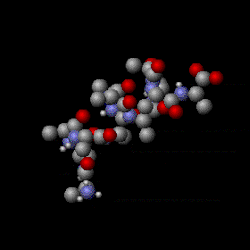A-level Chemistry/AQA/Module 5/Thermodynamics/Temperature and the Zeroth Law
Temperature and Thermal Equilibrium
[edit | edit source]It seems appropriate to start talking about thermodynamics by defining the concept of Temperature, however, we should first note some intuitive notions from everyday life.

Temperature is the measure of the average kinetic energy of the particles in a substance. An analogy can be drawn between the movement of atoms in the system, temperature, and the movement of, say, a group of balls. And just like a group of balls hit by a moving ball, the heat (and balls) tend to spread out; imagine a person playing pool hitting a group of billiards. They don't tend to stay in the same place, and, after the balls strike, the speed of each ball tends to look the same at a glance.

So what does this have to do with the zeroth law of thermodynamics?
First of all, humans have awareness of temperature; we can sense cold and hot things, and we historically set a numerical value to that sensation (we'll see how later).
Then, we have to look at how temperature changes. Let say that we have two litres of water separated and at different temperatures, say and . When we mix them, together they will get to a new temperature, , such that . So, we can say that the change of temperature has a direction towards equality. Note that although it is not always this way, we are saying that a whole body has a temperature, so the two litres together are a perfect mix between the two litres separated.
We don't need to mix object to make the temperatures equal; experience tells us that objects touching each other tend to become the same temperature. So, we can say that two bodies are at the same temperature when they don't change temperature if they are touching each other, this is called Thermal Equilibrium.
Thermal Equilibrium is reached between two objects when there is no difference in the temperature of the objects. Just like the billiard balls.
Zeroth Law of Thermodynamics
[edit | edit source]As a direct consequence of the definition of thermal equality, is that temperature measure is transitive; so, if we have three bodies, A,B and C, such that
and
then
- .
This is known as Zeroth Law of Thermodynamics.
Example:
Tea can be used as an example for the zeroth law of thermodynamics.
Say we have tea at 60 degrees Celsius and a 25 degree Celsius environment.
The tea will cool until it reaches and matches the 25 degree surroundings. The cup of tea displays the zeroth law of thermodynamics.
The Thermometer
[edit | edit source]We should say that this property allow us to build a thermometer, if we are able to translate temperature to a repeatable numeric value. In the above example (two litres of water evolving to a new temperature), we used the same quantity of water. The temperature scale is based in taking the final temperature as
for different masses of water we would have the weighted average
By changing the masses of water of known temperatures we could achieve by this mechanism every temperature between them and calibrate another (more comfortable) device that translates temperature to a repeatable numeric value. The most common device of this kind is the mercury thermometer, which is practically a bulb connected to a thin tube (a capilar). It was seen that the space that the mercury occupies in the tube increases with temperature lineally, so
where is the occupied space, and is the space occupied at a reference temperature ; is a constant (the linear thermal expansion coefficient). Celsius chose the temperatures as the temperatures of solidification and condensation of water, setting them as and and took the measure of a degree as a division of this range by 100. Fahrenheit instead, used the temperature of freezing brine as the of the scale and the human temperature as 96 (the water solidification was set to 32 °F). Later this scale was modified to have the condensation of water exactly 180 °F above the solidification.
Note that to build a temperature scale, one used a thermal stable mixture, a mixture that maintain constant temperature for a while. This is easily achieved using a compound which is changing state, like melting ice: the water is at the temperature of the ice, because they are at thermal equilibrium; the water then tend to get hotter (to reach equilibrium with air), and also the ice is in this process; when the ice melts, it turns into more water, that stabilizes the equilibrium with the existing water. Additionally, it was seen that there's an anomaly at change of states: thermal equilibrium between water and ice, for example, can be reached above (liquid) or beneath (solid) the solidification temperature, but also at the very solidification temperature, having as the final product a mixture between liquid and solid, or just liquid or just solid. This phenomenon is known as latent heat, and will be described further.

















